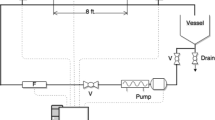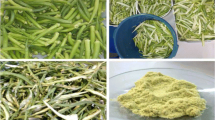Abstract
Synthetic Polyacrylamide based polymers and polysaccharides such as guar gum, xanthan gum carboxymethylcellulose and starch have been used for long. The Polyacrylamides are easily amenable to shear degradation although they are very efficient drag reducing and flocculating agents even at low ppm concentrations. On the other hand polysaccharides are fairly shear stable but are not very efficient drag reducers and flocculants. Their aqueous solution are also subjected to rapid biodegradation. It was contemplated that in the case where Polyacrylamide chains are grafted on polysaccharide backbones, efficient shear and biodegradation drag reducing and flocculating agents may be developed.
In the author’s laboratory, detailed investigation on synthesis and characterisation of graft copolymers of polysaccharides and Polyacrylamide was undertaken. It has been convincingly shown that these graft copolymers offer efficient, shear and biodegradation resistant drag reducing and flocculating systems. The laboratory scale synthesis has also been scaled up to batch reactor level.
The present paper outlines the details of synthesis and characterisation, structure-property relationship in regards to drag reduction, flocculation, shear stability and biodegradation resistance as well as the applications of these graft copolymers in systems of industrial importance. The graft copolymers are found to be highly solvated. The shear stability is correlated with the solvation number of graft copolymers. This indicates their applicability as super-absorbent materials. They can also be blended with polyolefines in order to develop biodegradable films. The various characteristics of these systems have been discussed in terms of current molecular theories of drag reduction and flocculation. The paper also covers some salient features of author’s work on application of drag reducing polymers in reducing the energy requirement of the sprinkler irrigation and reduction of percolation losses of soil as well as development of slow release urea based on blending with polysaccharides.
Access this chapter
Tax calculation will be finalised at checkout
Purchases are for personal use only
Preview
Unable to display preview. Download preview PDF.
Similar content being viewed by others
References
K.J. Misels, Flow of Thickened Fluids, U.S.Patent 24 92173, Dec. 27 (1949).
B.A. Toms, Some Observations on the Flow of Linear Polymer Solutions Through Straight Tubes at Large Reynolds Numbers, Proc. 1st. Rheology Congress Part 2, North Holland, 135 (1949).
R.P. Singh, Drag Reduction and Shear Stability Mechanism, in Encyclopedia of Fluid Mechanics, Polymer Flow Engineering, I. P. Cheremisinoff, Ed., Gulf Publishing, Houston, USA, Ch.14, Vol.9, 425 (1990).
S.E. Morgan and C.L. McCormick, Water Soluble Polymers in Enhanced Oil Recovery, Prog. Polym. Sci. 15, 103 (1990).
W.M. Kulicke, M. Kotter and H. Grager, Drag Reduction Phenomenon with Special Emphasis on Homogeneous Solutions, Adv. Polym. Sci., 89, 1 (1989).
W.K. Lee, R.C. Vaselski and A.B. Metzner, Turbulent Drag Reduction in Polymeric Solutions Containng Suspended Fibres, AIChE Journal 20, 128 (1975) .
S.R. Deshmukh, P.N.Chaturvedi and R.P.Singh, J.Appl.Polym. Sci. 30, 4013 (1985).
S.R. Deshmukh and R.P. Singh, Drag Reduction Effectiveness, Shear Stability and Biodegradation Resistance of Guar Gum-Based Graft Copolymers, J. Appl. Polym. Sci. 33, 1963 (1987).
S.R. Deshmukh and R.P. Singh, Drag Reduction Characteristics of Graft Copolymers of Xanthan Gum and Polyacrylamide, S.R.Deshmukh an R.P.Singh, J. Appl. Polym. Sci., 32, 6163 (1986).
R.P. Singh, S.R. Deshmukh and S.K. Majumdar, Studies on Turbuent Drag Reduction by Graft Copolymers, Proc. Xth. International Congress on Rheology, Sydney, Plenum Press, New York, Vol.2, 278 (1988).
S. Ungeheur, H.W. Bewersdorff and R.P. Singh, Turbulent Drag Effectiveness and Shear Stability of Xanthan-Gum-Based Graft Copolymers, J. Appl. Polym. Sci., 37, 2933 (1989).
S.R. Deshmukh, K. Majumdar and R.P. Singh, Drag Reduction Efficiency Shear Stability and Biodegradation Resistance of Carboxymethyl Cellulose-Based and Starch-Based Graft Copolymers, J.Appl.Polym.Sci., 43, 1091 (1991).
S. Majumdar and R.P. Singh, Turbulent Drag Reduction by Graftcopolymers of Poly(vinyl Alcohol) and Polyacrylamide, in Macromolecules, Current Trends, S. Venkatachalam, R. Ramaswamy, V.C. Joseph and V.N. Krishnamurthy Eds., Allied Publishers Ltd., New Delhi, Vol. II, 1076 (1995).
R.M. Kawalik, I. Duvdelani, D.F. Pfiffer, R.D. Lundenberg, K. Kitano and D.N. Shultz, Enhanced Drag Reduction Via Interpolymer Association, J. NonNewtonian Fluid Mech. 24, 1 (1987).
S. Malik, S.N. Shintre and R.A. Mashelkar, Enhancing the Shear Stability in Drag-Reducing Polymers Through Molecular Associations, Macromolecules 26, 55 (1993).
J. Bratby, Coagulation and Flocculation, Uplands Press Ltd., Croydon, England (1980).
J. Gregory, Flocculastion by Polymers and Polyelectrolytes, In Solid/Liquid Dispersions, Th.F. Tadros Ed., Academic Press Inc., London, 163 (1987).
K. Kannan, Guar Gum Based Graft Copolymers: Flocculastion and Rheological Behaviour, M.Tech. Thesis, Materials Science Centre, I. I. T., Kharagpur, India (1988)..
S.K. Jain, Flocculating Agents Based on Guargum-g-Acrylamide for Industrial Effluents Treatment, M.Tech. Thesis, Materials Science Centre, I. I. T., Kharagpur, India (1989).
N. T. Lan, Flocculant Based on Xanthan-g-Acrylamide, M.Tech. Thesis, Materials Science Centre, I. I. T., Kharagpur, India (1990).
G.P. Karmakar, Flocculation and Rheological Properties of Grafted Polysaccharides, Ph.D.Thesis, Materials Science Centre, I. I. T., Kharagpur, India (1994).
R.H.J. Sellin, J.W. Hoyt, J. Poliert and O. Scrivener, The Effect of Drag Reducing Additives on Fluid Flows and Their Industrial Applications: Part II, Present Appliations and Future Proposals, J. Hydraulic Res., 20, 235 (1982).
R.H.J. Sellin, Industrial Applications for Drag REducing Polymer Additives: A Review Proc. Third International Conf. on Drag Reduction, Bristol, U.K., R.H.J. Sellin and M.T. Moses Eds. I 3–1 (1984).
R.P. Singh, J. Singh, D. Kumar and A. Kumar, Novel Applications of Drag Reducing Polymers in Agriculture, in Drag Reduction in Fluid Flows: Techniques for Friction Control; R.H.J. Sellin and M.T. Moses, Eds. Ellis Horward, Chichester, U.K., D.4–1 (1990).
R.P. Singh, J. Singh, S.R. Deshmukh, D. Kumar and A. Kumar, Application of Drag-Reducing Polymers in Agriculture, Current Science, 68, 631 (1995).
R.P. Singh, Novel Flocculasnts Based on Grafted Polysaccharides, Popular Plastics and Packaging, 39(5), 69 (1994)
R.P. Singh, G.P. Karmakar, N. Lan and S.K. Jain, Development and Investigation on Bidegradable Flocculants for the Treatment of Industrial Effluents. Souvenir Masterials Research Society of India, 6th. Annual General Meeting, I. I. T., Kharagpur, India, PM9 (Feb.8–10, 1995).
J.W. Hoyt, Drag Reduction, in Encyclopedia of Polymer Science and Engineering, Vol. 5, Second Edition, John Wiley and Sons INc., 129 (1986).
J.W. Hoyt, Drag Reduction in Polysaccharide Solutions, Trends in Biotechnology, 3, 1 (1985).
J.K. Seaman ‘Guar Gum’ In Handbook of Water Soluble Gums and Resins, R.L. Davidson Ed., McGraw Hill Inc., New York 6 (1980).
P.J. Whitcomb, J. Gatowski and W.M. Howland, Rheology of Guar Gum Solutions, J. Appl. Polym. Sci. 25, 2815 (1980).
W. Brostow, Drag Reduction and Mechanical Degradation in Polymer Solutions in Flow, Polymer, 24, 631 (1983) .
W. Brostow, H. Ertepinar and R.P. Singh, Flow of Dilute Polymer Solutions: Chain Conformations and Degradation of Drag Reducers., Macromolecules 23, 5109 (1990).
R.P. Singh, Turbulent Drag Reduction by Polymer Based Mixtures and Graftcopolymers, Current Science, 68, 736 (1995)
S. Majumdar and R.P. Singh, J. Acous. Soc. India, 21, 229 (1993).
A.F. Horn and E.W. Merrill, Extensional Flow Induced chain Scission of Macromolecules in Dilute Solution. Effectof Solvent Power in a Mixed Solvent System, Polymer Communcations, 28, 172 (1987).
A. Keller and J.A. Odell, The Extensibility of Macromolecules in Solution: A New Focus for Macromolecular Science, Colloid and Polym. Sci. 263, 181 (1985).
F. Beuche, Mechanical Degradation of High Polymers, J. Appl.Polym. Sci. 4, 101 (1960).
R.P. Singh, S.K. Jain and N. Lan, Drag Reduction, Flocculation and Rheological Characteristics of Grafted Polysacchasrides. In Polymer Science Contemporary Themes, S. Srivaram Ed., Tata McGraw Hill Publishing Compary Ltd., New Delhi, 716 (1991).
G.M. Moody, The Use of Polyacrylamides In Mineral Processing, Minerals Enginering 5, 479 (1992).
R.K. Sivanappam, Thrust on Irrigation Harvesting, The Hindu Survey of Indian Agriculture, Madras, India, 155 (1994) .
V. Elias and J. Vocel, Long Term Field Expriments with Polymer Additives for Sprinkler Irrigation, Communications of the Institute of Hydrodynamics, Prague, No. 10 (1980).
S.H. Holey, R.P. Singh and J. Singh, Application of Drag Reducing Energy Requirement of Sprinkler Irrigation System, J. Agri. Engg., India 16, 53 (1979).
G. Sankar, R.P. Singh and J. Singh, Applications of Drag Reducing Polymers in Reducing Energy Requirement of Sprinkler Irrigation System II, J. Agri. Engg., India 19, 9 (1982).
M.B. Nagdeve, K.N. Tiwari and R.P. Singh, The Reduction in Energy Requirement of Sprinkler Irrigation System by Purified Guar Gum. J. Agri. Engg., India 23, 310 (1986).
M.B. Nagdeve, K.N. Tiwari and R.P. Singh, The Effect of Drag Reducing Guar Gum on Hydraulic Conductivity of Soil, J.Agri. Engg., India 23, 217 (1986).
A. Kumar, R.P. Singh and J. Singh, Application of the Guar Gum Polymer for Controlling Pecolation Losses under Ponded Conditions in Paddy Fields, J. Indian, Water Resources Soc. 8, 53 (1988).
S. Phukan, Application of Drag Reducing Polymers in Reducing. The Energy Requirement of Sprinkler Irrigation System, M.Tech. Thesis, Agriculture Engg. Deptt., I.I.T., Kharagpur, India (1993).
S.C. Kotur, Relative Efficacy of Different -Forms of Urea on Rainy-season Cauliflower and Brinjal on Alfisol of Chhotanagar, Ind. J. Agri. Sci. 63, 436 (1993).
C. Hepburn and R. Arizal, A Controlled Release Urea Fertilizer Part I: The Encapsulation of Urea Fertilizer by Rubber: Processing and Vulcanisation Procedures, Plastics and Rubber Proc. Appl. 12, 129 (1989).
S. Majumdar, S.H. Holay and R.P. Singh, Adiabatic Compressibility and Solvation of Drag Reducing Polymers in Aqueous Solutions, Eu. Polym. J. 16, 120 (1982).
G.P. Karmakar, R.P. Bhagat, D.M. Chakraborty and R.P. Singh, Flocculation Studies on Hematite Mineral Using Starch-g-Polyacrylamide, In Polymer Science, Recent Advances, Vol. 2, I.S. Bhardwaj Ed., Allied Publishers Ltd., New Delhi 990 (1994).
Author information
Authors and Affiliations
Editor information
Editors and Affiliations
Rights and permissions
Copyright information
© 1995 Springer Science+Business Media New York
About this chapter
Cite this chapter
Singh, R.P. (1995). Advanced Turbulent Drag Reducing and Flocculating Materials Based on Polysaccharides. In: Prasad, P.N., Mark, J.E., Fai, T.J. (eds) Polymers and Other Advanced Materials. Springer, Boston, MA. https://doi.org/10.1007/978-1-4899-0502-4_24
Download citation
DOI: https://doi.org/10.1007/978-1-4899-0502-4_24
Publisher Name: Springer, Boston, MA
Print ISBN: 978-1-4899-0504-8
Online ISBN: 978-1-4899-0502-4
eBook Packages: Springer Book Archive




